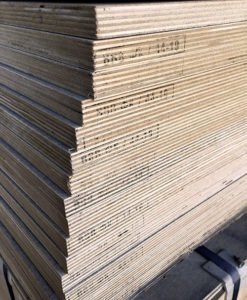Plywood is confusing. There, I said it. Plywood pricing is even more confusing. Plywood thicknesses are a major factor in quality and pricing. But the thickness isn’t always consistent. This is especially true when it comes to how the sheet of plywood is constructed. You can have 2 panels of identical species and thickness, but is one sheet the same as the other? Is a 3/4 sheet with 12 plies actually better than a 3/4″ sheet with 6 plies? Moreover plywood thicknesses of one manufacturer’s 3/4″ sheet may not be the same as the next maker’s 3/4″ sheet
As always, the answer is a frustrating and maddening, “maybe.”
Plywood Thicknesses will vary

In theory, more plies is better and not because the veneers are cut thinner and their movement is less. Also thinner plies means it is easier to maintain a consistent moisture content throughout the ply and from one to another. Actually, it is because more plies means more glue. Basically, we are getting closer to a synthetic product than an organic, hydroscopic one. The more glue we have, the more stable the panel will be. The increased amount of glue holds the wood’s natural tendency to move in check. So “better” is not really about the wood and the thickness of the plies, but all about the glue. Plywood thicknesses are determined by the individual plies, the glue, and the manufacturing process itself.
And this is where the “maybe” part comes into play. If a poor quality glue is being used, then you have more glue lines filled with crap, and the end result is most definitely NOT a better sheet of plywood.
So to the legions of people out there counting the number of plies in your panel to determine whether it is a quality product, I say to you that you would be much better served looking at the type of glue being used and the quality control relating to glue application.
There are not a lot of different formulations of glue out there, so the glue in your plywood is only about 10% a chemistry issue and more about the application. Many foreign mills will use extenders to increase the coverage of the glue (basically they are watering down the glue). At the same time automation in the plywood mill has allowed for thinner glue lines to further extend the same volume of glue. Automation is great, and it has allowed the costs of products to decrease, but even a fully automated plant needs to make sure the glue vat doesn’t run dry while the line is still running. I’ve seen panels delaminate only to discover that there is little to no glue between the plies, and only the residue on the rollers and the heat and pressure had held it together.
Glue is expensive. In fact, is it common to expect that 30% of the cost of your sheet of plywood is in glue. Moreover, the cost of glue is a constant, and while the cost for the wood itself in plywood may vary dramatically based on grade and species, the cost of the glue remains the same. So when a mill wants to reduce costs or increase margins, the first thing to be changed is the glue. When you can take the same volume of glue and extend it to make 20 more panels, then you have a definite savings. As I stated above, glue is very important to the quality of the panel, but it is also the most manipulated element of the production process.
This means that you can know exactly the type and formula of the glue being used, but you can’t rely entirely on that to determine the quality of a panel. Quality control and consistency in the manufacturing process is important here. To the average buyer this is a very frustrating statement, because at the end of the supply chain it is very difficult to ask questions about the manufacture process and the quality control measures involved.
The buyer either doesn’t know the questions to ask or the dealer doesn’t know the answers, because the panel was manufactured 6 levels up the supply chain.
Plywood Pricing dictates quality

What are we to do to ensure we can get a good quality sheet of plywood?
Simple, start at the end and work backwards. Think of a time when you had a great plywood experience. What made that a good experience? The answer to this will vary for each of us depending on what we were building. Some prize appearance of the face, some look for a dead flat panel that stays that way. Others look to the core construction to be sound with no voids and patches so that the panel mills like solid wood.
Can you picture that sheet of plywood? Good, now what did you pay for it? Start there and go to your dealer with the important attributes and price in mind. We have all heard the negotiation adage, “never throw out the first number.” This is an instance where that is exactly the wrong advice. Plywood mills are magnificent operations that can turn on a dime and manufacture a product with exactly the specifications you need. So if you come to me and say I need an A1 Cherry panel, and I want to spend $75, the mill can make that for you. If you say you only want to spend $56, guess what? The mill can make that for you too. Is it the same product?
Absolutely not!
What is Grade A Plywood?
Somewhere along the line, the face veneer, the glue, the core construction, etc. was changed to meet a price point. When you see “grade A” plywood this is really only referring to the face veneer. But what makes a quality plywood panel is so many things and often relative to the user. Plywood thicknesses and consistency may be most important to one while quality of the face is important to another. This is why you must have a solid idea of what quality means to you concerning plywood. If you have never had a good plywood experience then you can do just the opposite and catalog all the things that you didn’t like and then go to your dealer with that list. A decent plywood dealer will understand these variables and will be able to craft a combination of components to suit your needs. They may not have it in stock at the moment, but they can probably point you to a stocked product that matches what you are looking for.
In fact, examining the variety of stock your dealer carries and paying close attention to the price differences provides for an excellent education. Find out why this panel costs $7 more than the one next to it. This will illustrate exactly how small changes in the composition and manufacture of the panel translates back to the price tag. It will also guide you to the price you should be paying instead of just buying whatever is on the shelf. Contrary to popular belief, price differences from one dealer to another is rarely about one guy trying to make more profit than the other. A price difference is a key indicator that the product itself is different and your working results will be different with that panel.

Whew! Lots to think about here. We started this little journey talking about counting plies and ended up in a pricing battle comparing one dealer to another or one product to another.
Take this same article and substitute counting plies with anything else: flatness, core species, face species, manufacturer origin, whatever, and then continue down the same path to price. Plywood thicknesses are only one factor to consider. It doesn’t matter what element you focus on; the true indicator of a quality plywood panel (whatever that may mean to you) comes down to the price of the finished product. This one element will tell you if you are comparing apples to apples or looking at two different products. If they are different, then what a great opportunity to ask some questions and learn what makes them different. Your understanding of plywood composition and manufacture will increase immensely, and you will end up finding your perfect panel and knowing what you should be paying no matter what dealer you visit.
Learn more about the lumber industry:









This is very good information. When first introduced to marine plywood many decades ago we were buildng high performance outboard boats. My mentor was very particular and the quality of the laminations and the glue. We would have to travel a day and a half each way to purchase the quality he sought.. Naturally we bought all he could afford. The standards were required for the beating the boats took. To this day I have followed his lead and spent the extra funds to get the best sheets for the furniture and cabinets I build. Nice job.
Thank you.
Great, informative article, thank you.
Appreciate your post. Very informative. Look forward to future posts.
Howard Classic Boats, LLC.
Excellent article. There likely are others who know as much or more than Shannon about the origins, biology, physics and chemistry of wood and commercially available wood products, Gene Wengert’s writing in FDMC and other places certainly is a good example of another very knowledgeable and scholarly contributor. But in my experience, without question, Shannon is the best communicator of the information out there – both written and spoken. I believe that his hands on experience working wood with tools provides the basis for his excellent insights on wood issues that are pertinent and important to others who build with wood, I always look forward to hearing or reading his opines on wood, wood products, and wood-related issues. In actuality, it is Shannon who is the real technical “wood whisperer.”
Aww shucks Jim, you’re too kind.
The strength of the plywood is not just about the glue. A large part of it is also that the grain of each ply is turned 90 degrees from the last before gluing. So having more plies also adds more rigidity in the other direction.